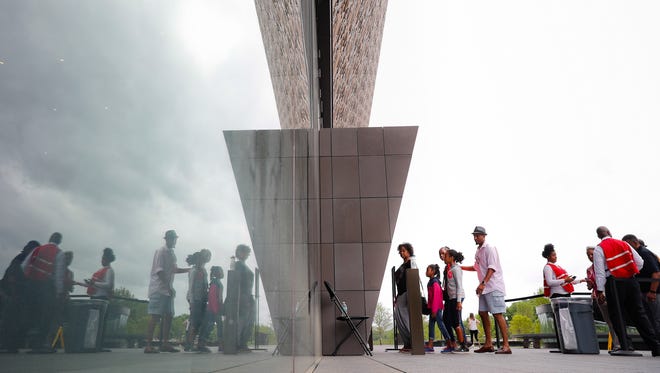Former Charleston mayor: To heal Charlottesville, tell African-American story
We’re fighting today about statues and flags because we have yet to deal openly and honestly enough with our full past.

The horrific violence in Charlottesville, Va., has stirred painful memories of the night we lost nine neighbors, African Americans killed in the name of racial hatred while attending Bible study, two years ago last June.
Much like the senseless murders at Emanuel African Methodist Episcopal Church, the marching of white supremacists and neo-Nazis through the streets of Charlottesville has been a shocking reminder of the harrowing racism that still smolders at the core of the American experience, divides us as people, and holds us back as a nation.
This, regrettably, will not end in Charlottesville, as it did not end in Charleston. We’re likely to see more such face-offs in other places, as cities across the South, and across the nation, struggle to reconcile two starkly different visions of the past we share.
One view is shaped by an effort to come to terms with centuries of slavery followed by racial injustice that endures to this day. The other view largely ignores that part of our national story and seeks to submerge it beneath oceans of silence, indifference and outright neglect.
We’re fighting today about statues and flags because we have yet to deal openly and honestly enough with that part of our past to reach a common understanding of who we are as American people, how we’ve come to this point, and where we’re going from here.
More:Ferguson still struggling with racial bias
More:Trump's moral failures on Charlottesville are shredding America's global reputation
Doing that will require a faithful reckoning with this painful past. That means telling the full story about the people who were forced from their African homes in chains to work as slaves helping to build a nation that would deny them the fruits of their labors and the promise of a land they enabled to prosper beyond anyone’s wildest imaginings.
We took a giant step forward with the recent opening of the National Museum of African American History and Culture. In showcasing the ways African Americans have helped shape this country and touched our lives, the museum is advancing a more complete story essential to understanding our country.
And we’re working to do our part in Charleston, a former slave port through which passed 40% of the Africans who came to this country in chains.
Part of our history is front and center in Charleston, a place where horse-drawn carriages ferry visitors down cobbled streets past antebellum mansions and white-steeple churches. There is, though, a far richer story we’re just beginning to tell, a deeply human story of struggle and sacrifice, achievement and triumph.
It’s the story of the largest forced migration the world has ever known, a story of unrequited labors and skills that built the grand houses and government buildings that still capture our imaginations today. It’s the story of men and women who brought vast riches to this region centuries ago by carving rice, indigo and cotton empires out of malarial low-country swamps. It’s the story of music, language, literature and art carried across the Atlantic and passed down from one generation to the next. And it’s the story of culinary traditions born a continent away and baked into every supper served in the kitchens of Charleston.
It’s the story, also, of human beings staggering out of the fetid holds of slavers’ ships. Of people stripped and sold in the slave market near the harbor waters that ushered more than 200,000 enslaved Africans into this country. Of centuries of slavery, enforced by the lash and the chain and the noose. Of generations more of Jim Crow, segregation and the systematic denial of essential rights.
POLICING THE USA: A look at race, justice, media
More:Trump is right — violent extremists on both sides are a threat
And it’s the story of oppression that lingers still, bearing tiki torches and swastikas on the streets of Charlottesville, or echoing in gunshots ringing out from Mother Emanuel Church.
To breathe life into that vital story, we’ll begin construction next year on the International African American Museum, on the former site of Gadsden’s Wharf. One of the most sacred African-American sites in the Western Hemisphere, this is hallowed ground, the place where the vast majority of enslaved Africans brought to Charleston disembarked from the bellies of slave ships. We’re committed to telling their story unvarnished, in the hope that we might move, as a nation, toward a more honest rendering of history.
Our goal is to honor the contributions of all our people, acknowledge the burden so many were forced to bear, and set the table for a deeper inquiry into the past we all share. Only then can we begin to heal the wounds of racial injustice, bridge the gulf that divides us still, and come together at last around a common understanding of who we truly are as American people.
Joseph Riley Jr., professor of American Government and Public Policy at The Citadel, served as mayor of Charleston from 1975 to 2016 and is a board member of the International African American Museum.
You can read diverse opinions from our Board of Contributors and other writers on the Opinion front page, on Twitter @USATOpinion and in our daily Opinion newsletter. To respond to a column, submit a comment to letters@usatoday.com.